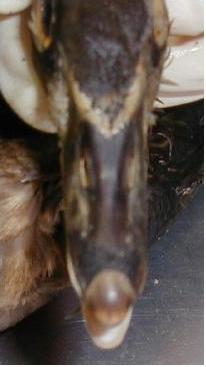System


Birds have an extensive respiratory
system. Like mammals, birds have 2 lungs connected to a trachea and
ventilated by an aspiration pump. However, beyond that, birds have
a unique respiratory system. Air is inhaled through the external
nares and enters through the internal nares. Air travels through
the pharynx and into the larynx
which is protected from food and liquids by the epiglottis that covers
the
glottis opening. Continuous with the
larynx is the trachea. The trachea is
supported by lateral cartilaginous rings that prevent collapsing while
allowing expansion of the trachea. Air then splits at the Syrinx
(sound mechanism) and travels down the bronchi (mesobronchi). The
bronchi branches repeatedly and form parabronchi (one-way passageways)
that lead to the lungs. Small capillaries open off the parabronchi;
this is the site of gas exchange with the blood capillaries. Avian
lungs are located in the dorsal wall of the thoracic cavity.
Nine air sacs are connected to the lungs. These air
sacs extend into the bones, replacing marrow. There is still
much debate over the function of avian air sacs; -theories include lightening
the bird, cooling the testes, providing lift, etc. However none of
these are feasible. The current proposal is that air sacs function
as bellows. Avian lungs themselves do not change shape with rib cage
motion. Compression and expansion of the rib cage acts on the air
sacs, drawing the air through them and into the lungs (Kardong, 2002).
A bird's respiratatory system is adapted
to its oxygen demands. Birds have ten times more respiratory surface
area than any other mammal of the same size. Also, oxygenated air
passes across the lung with each inspiration.